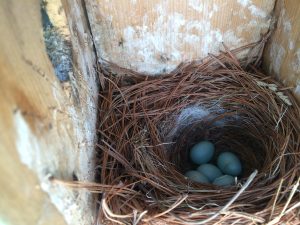MAINTENANCE
General: Periodically, but at least once a year in February or March, check the boxes to see that they are structurally sound and are upright and firmly attached to their poles/trees/buildings. Also be sure that the opening has not been enlarged by squirrels. (If so, you may need a new box enforced with metal around the hole). Contact Willistown Conservation Trust at land@WCTrust.org if you have questions or need assistance.
Bluebird and House Wren Boxes:
- Clean out at least once per year-in the fall, after the end of the nesting season.
- It is also advisable to clean out these boxes after each brood has fledged (young birds have left the nest box). Bluebirds and House Wrens will often raise more than one family, using the same box. Old nests should be thrown out if possible so that new nests are not piled on top of old nests.
- Use a putty knife or spatula to lift the old nesting material out and to scrape any material, such as insect nests, bird droppings and dead skin from the sides and bottom of the box. If lice are present, spray the box with a weak bleach solution and leave the box open for a day to dry.
- No wood shavings are necessary.
Kestrel Boxes:
- If Kestrel boxes can be safely reached, they should be cleaned out in early spring, preferably prior to March.
- The boxes should have a couple of inches of wood shavings in them prior to the nesting season.
- If Kestrel boxes cannot be safely reached, leave them alone, or call WCT.
Screech Owl Boxes:
- Check Screech Owl boxes for repairs, but do not clean them out.
- Note-We use the same bird box design for both Kestrels and Screech Owls, but put them in different types of locations. We will make it clear which species a particular box is meant to attract.
Wood Duck Boxes:
- Wood Duck boxes should be cleaned out in summer after the ducklings have left the box.
- Put about four inches of fresh wood shavings in the boxes.
- The Wood Duck boxes we install are put on poles which enable the boxes to be lowered for convenient maintenance.
MONITORING
NestWatch: We urge you to check out NestWatch, a citizen science program of the Cornell Lab of Ornithology.
General:
- Monitoring your bird boxes will increase the chances of nesting success. As noted below, you can take actions to remove threats. Note that you may and should remove European Starlings and House (English) Sparrows, but must not remove other species of birds from the boxes.
- Monitoring will also increase your family’s enjoyment and, if you participate in NestWatch, add to our storehouse of bird knowledge (as well as your own!).
Bluebirds and House Wrens:
- Bluebirds and Wrens (in addition to other species that might use these boxes like Tree Swallows) are quite tolerant of nest box checks, if done occasionally. Check the boxes periodically, preferably weekly or more. Approach from the side of the box and knock lightly on the box before opening it.
- Do not handle the eggs or baby birds.
- Do not check the boxes in early morning or at dusk. Also, when the young birds are close to fledging, do not disturb the box, in order to avoid causing them to leave the box too soon.
- Remove dead chicks or adults. If the box has become infested with insects and killed the chicks, clean it out completely and disinfect it.
- If boxes are taken over by House Sparrows, remove their eggs/nests as soon as possible.
Other Bird Boxes:
- We suggest you observe Kestrel, Screech Owl and Wood Duck boxes remotely, using binoculars, if available. These species are much less tolerant of human disturbance. These boxes can be more closely monitored, if done correctly. We strongly suggest you contact us if you wish to do so.
- Screech Owls are protective of their nests and will make threatening flights at intruders who come too close for their liking.
KEEP CATS INDOORS!!


